2006 DODGE STRATUS SEDAN warning lights
[x] Cancel search: warning lightsPage 11 of 296
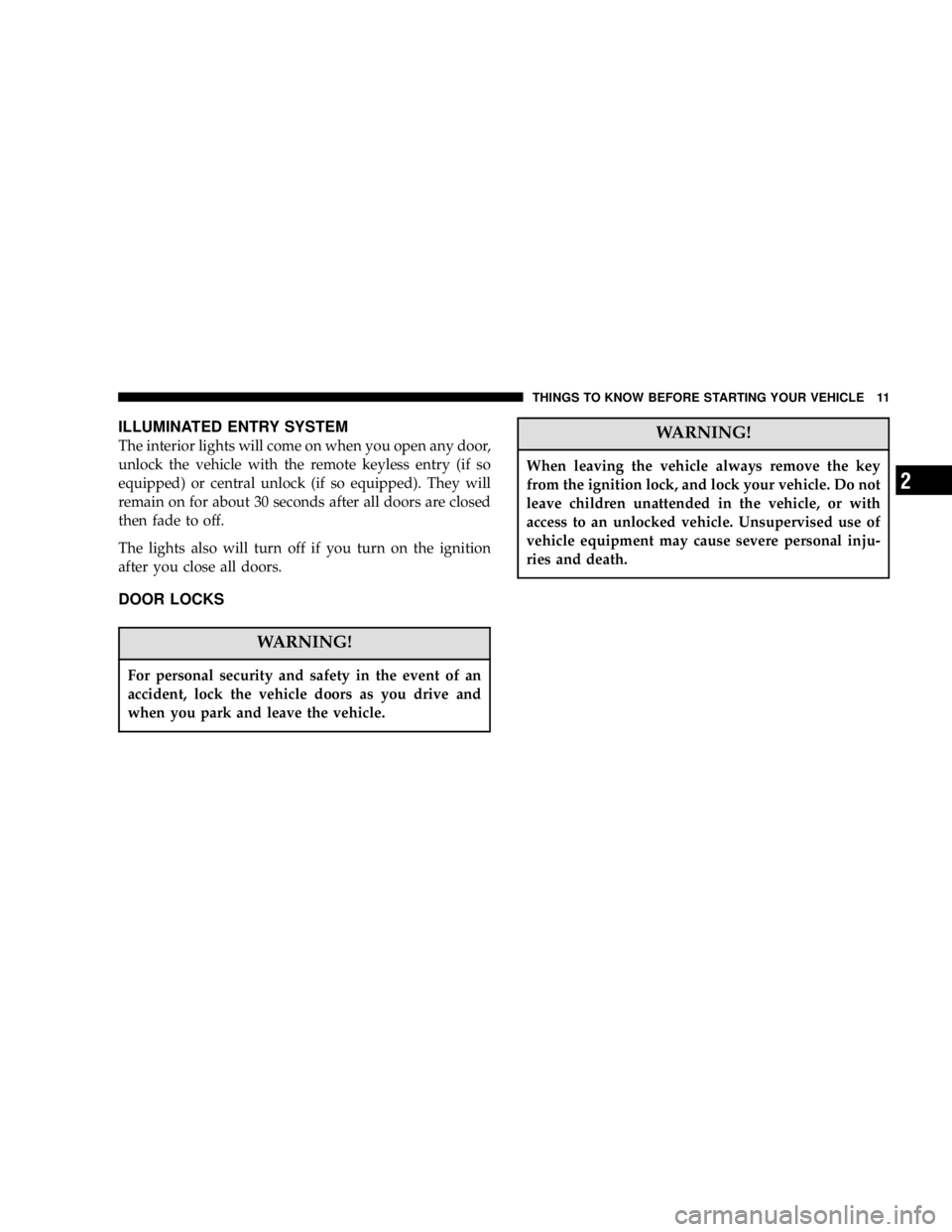
ILLUMINATED ENTRY SYSTEM
The interior lights will come on when you open any door,
unlock the vehicle with the remote keyless entry (if so
equipped) or central unlock (if so equipped). They will
remain on for about 30 seconds after all doors are closed
then fade to off.
The lights also will turn off if you turn on the ignition
after you close all doors.
DOOR LOCKS
WARNING!
For personal security and safety in the event of an
accident, lock the vehicle doors as you drive and
when you park and leave the vehicle.
WARNING!
When leaving the vehicle always remove the key
from the ignition lock, and lock your vehicle. Do not
leave children unattended in the vehicle, or with
access to an unlocked vehicle. Unsupervised use of
vehicle equipment may cause severe personal inju-
ries and death.
THINGS TO KNOW BEFORE STARTING YOUR VEHICLE 11
2
Page 15 of 296
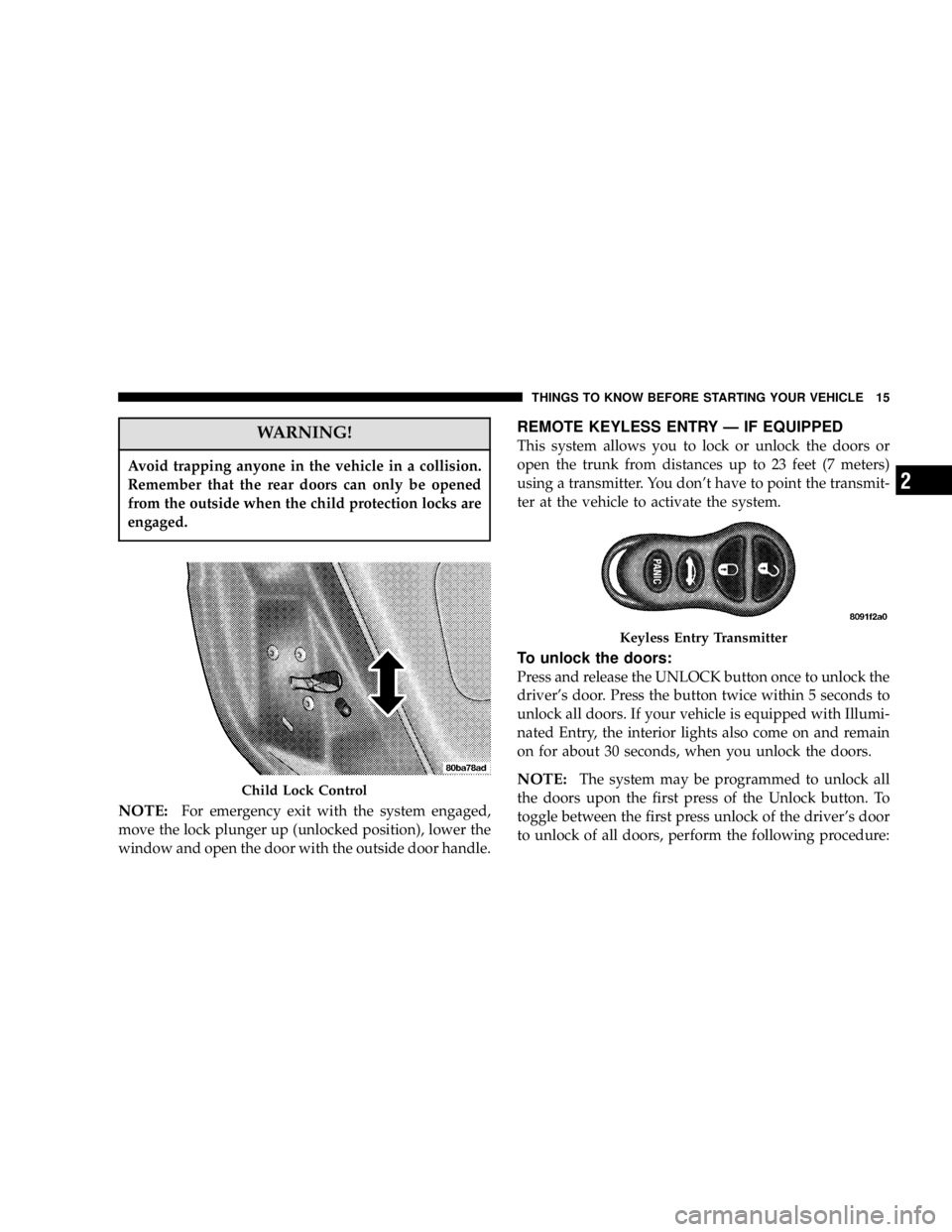
WARNING!
Avoid trapping anyone in the vehicle in a collision.
Remember that the rear doors can only be opened
from the outside when the child protection locks are
engaged.
NOTE:For emergency exit with the system engaged,
move the lock plunger up (unlocked position), lower the
window and open the door with the outside door handle.
REMOTE KEYLESS ENTRY—IF EQUIPPED
This system allows you to lock or unlock the doors or
open the trunk from distances up to 23 feet (7 meters)
using a transmitter. You don’t have to point the transmit-
ter at the vehicle to activate the system.
To unlock the doors:
Press and release the UNLOCK button once to unlock the
driver’s door. Press the button twice within 5 seconds to
unlock all doors. If your vehicle is equipped with Illumi-
nated Entry, the interior lights also come on and remain
on for about 30 seconds, when you unlock the doors.
NOTE:The system may be programmed to unlock all
the doors upon the first press of the Unlock button. To
toggle between the first press unlock of the driver’s door
to unlock of all doors, perform the following procedure:Child Lock Control
Keyless Entry Transmitter
THINGS TO KNOW BEFORE STARTING YOUR VEHICLE 15
2
Page 31 of 296
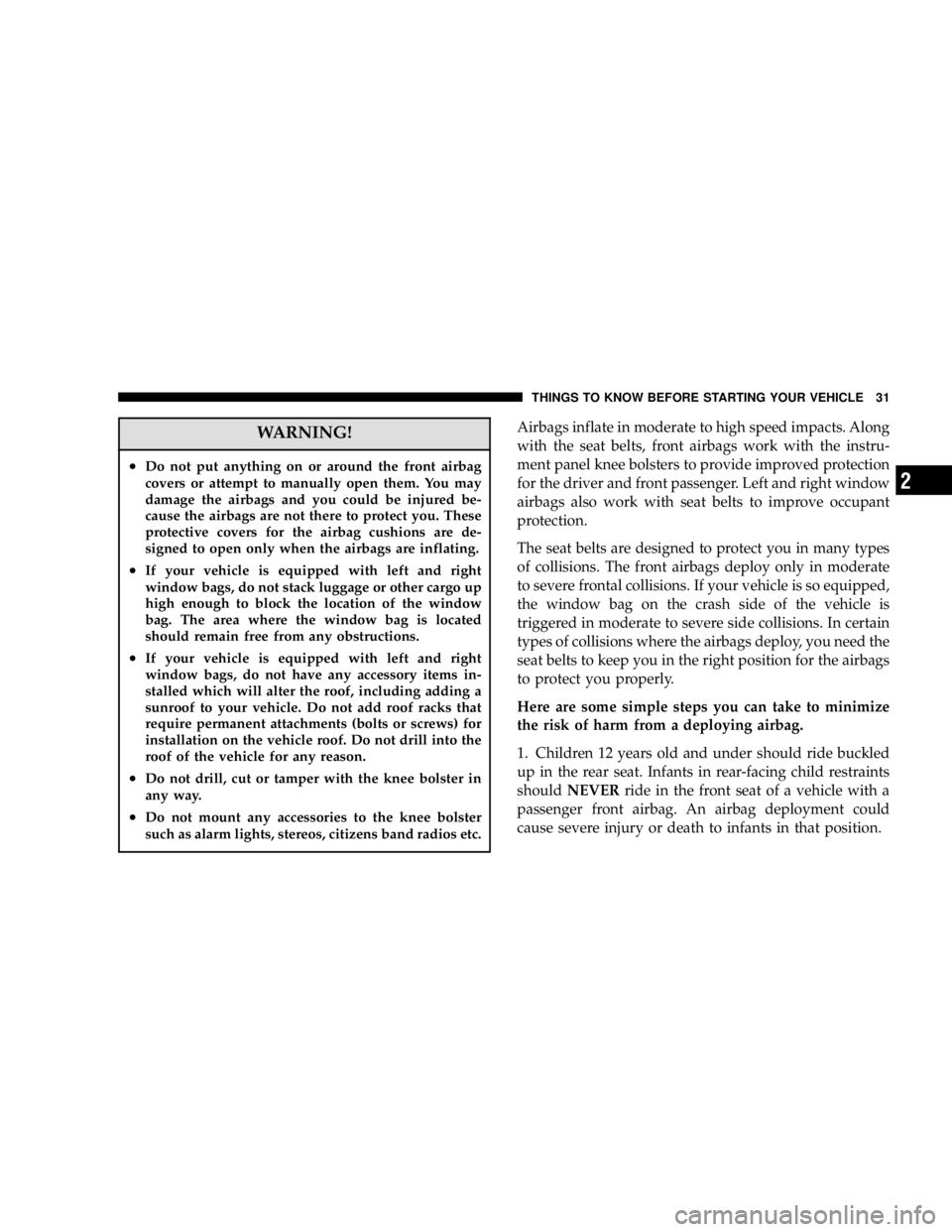
WARNING!
•Do not put anything on or around the front airbag
covers or attempt to manually open them. You may
damage the airbags and you could be injured be-
cause the airbags are not there to protect you. These
protective covers for the airbag cushions are de-
signed to open only when the airbags are inflating.
•If your vehicle is equipped with left and right
window bags, do not stack luggage or other cargo up
high enough to block the location of the window
bag. The area where the window bag is located
should remain free from any obstructions.
•If your vehicle is equipped with left and right
window bags, do not have any accessory items in-
stalled which will alter the roof, including adding a
sunroof to your vehicle. Do not add roof racks that
require permanent attachments (bolts or screws) for
installation on the vehicle roof. Do not drill into the
roof of the vehicle for any reason.
•Do not drill, cut or tamper with the knee bolster in
any way.
•Do not mount any accessories to the knee bolster
such as alarm lights, stereos, citizens band radios etc.
Airbags inflate in moderate to high speed impacts. Along
with the seat belts, front airbags work with the instru-
ment panel knee bolsters to provide improved protection
for the driver and front passenger. Left and right window
airbags also work with seat belts to improve occupant
protection.
The seat belts are designed to protect you in many types
of collisions. The front airbags deploy only in moderate
to severe frontal collisions. If your vehicle is so equipped,
the window bag on the crash side of the vehicle is
triggered in moderate to severe side collisions. In certain
types of collisions where the airbags deploy, you need the
seat belts to keep you in the right position for the airbags
to protect you properly.
Here are some simple steps you can take to minimize
the risk of harm from a deploying airbag.
1. Children 12 years old and under should ride buckled
up in the rear seat. Infants in rear-facing child restraints
shouldNEVERride in the front seat of a vehicle with a
passenger front airbag. An airbag deployment could
cause severe injury or death to infants in that position.
THINGS TO KNOW BEFORE STARTING YOUR VEHICLE 31
2
Page 54 of 296
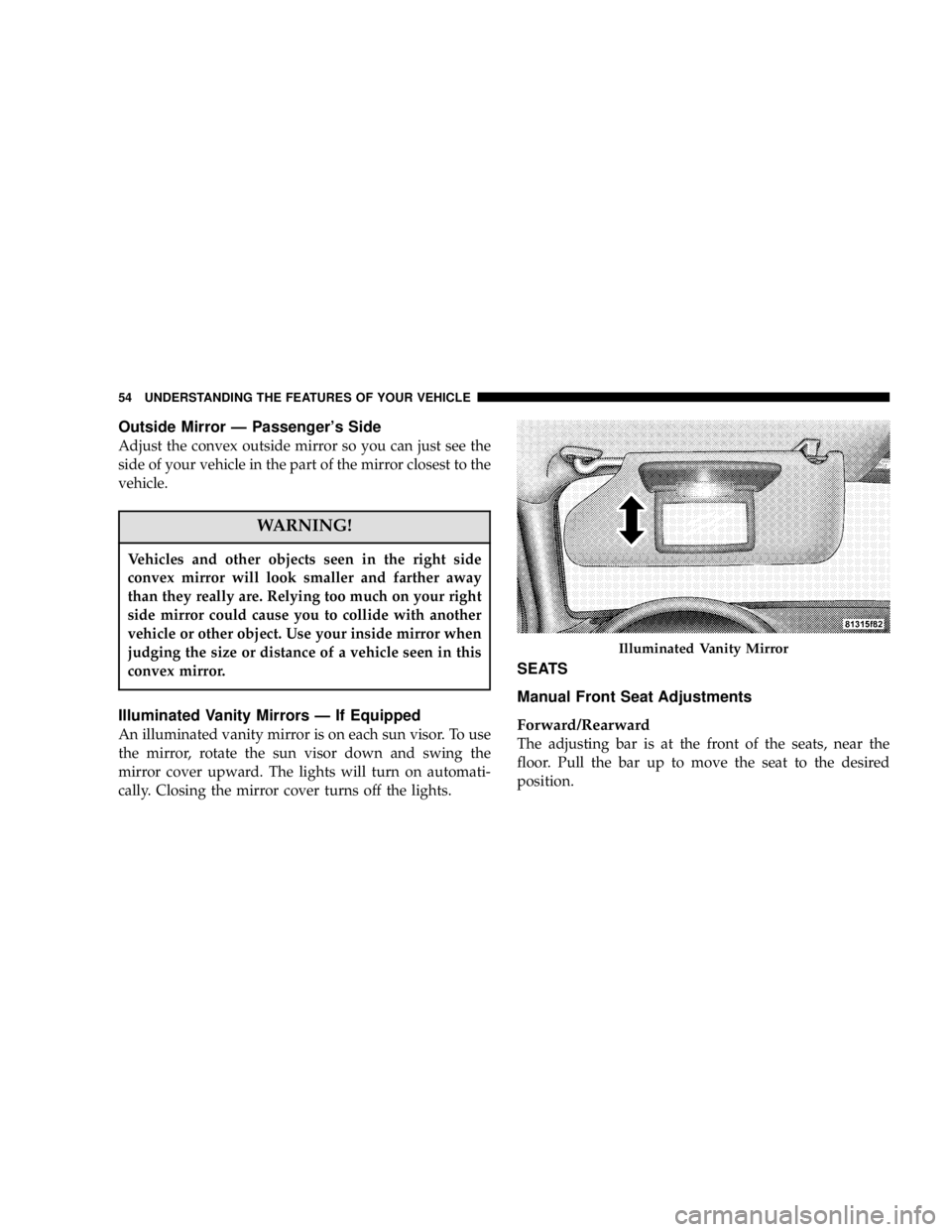
Outside Mirror—Passenger’s Side
Adjust the convex outside mirror so you can just see the
side of your vehicle in the part of the mirror closest to the
vehicle.
WARNING!
Vehicles and other objects seen in the right side
convex mirror will look smaller and farther away
than they really are. Relying too much on your right
side mirror could cause you to collide with another
vehicle or other object. Use your inside mirror when
judging the size or distance of a vehicle seen in this
convex mirror.
Illuminated Vanity Mirrors—If Equipped
An illuminated vanity mirror is on each sun visor. To use
the mirror, rotate the sun visor down and swing the
mirror cover upward. The lights will turn on automati-
cally. Closing the mirror cover turns off the lights.
SEATS
Manual Front Seat Adjustments
Forward/Rearward
The adjusting bar is at the front of the seats, near the
floor. Pull the bar up to move the seat to the desired
position.
Illuminated Vanity Mirror
54 UNDERSTANDING THE FEATURES OF YOUR VEHICLE
Page 59 of 296
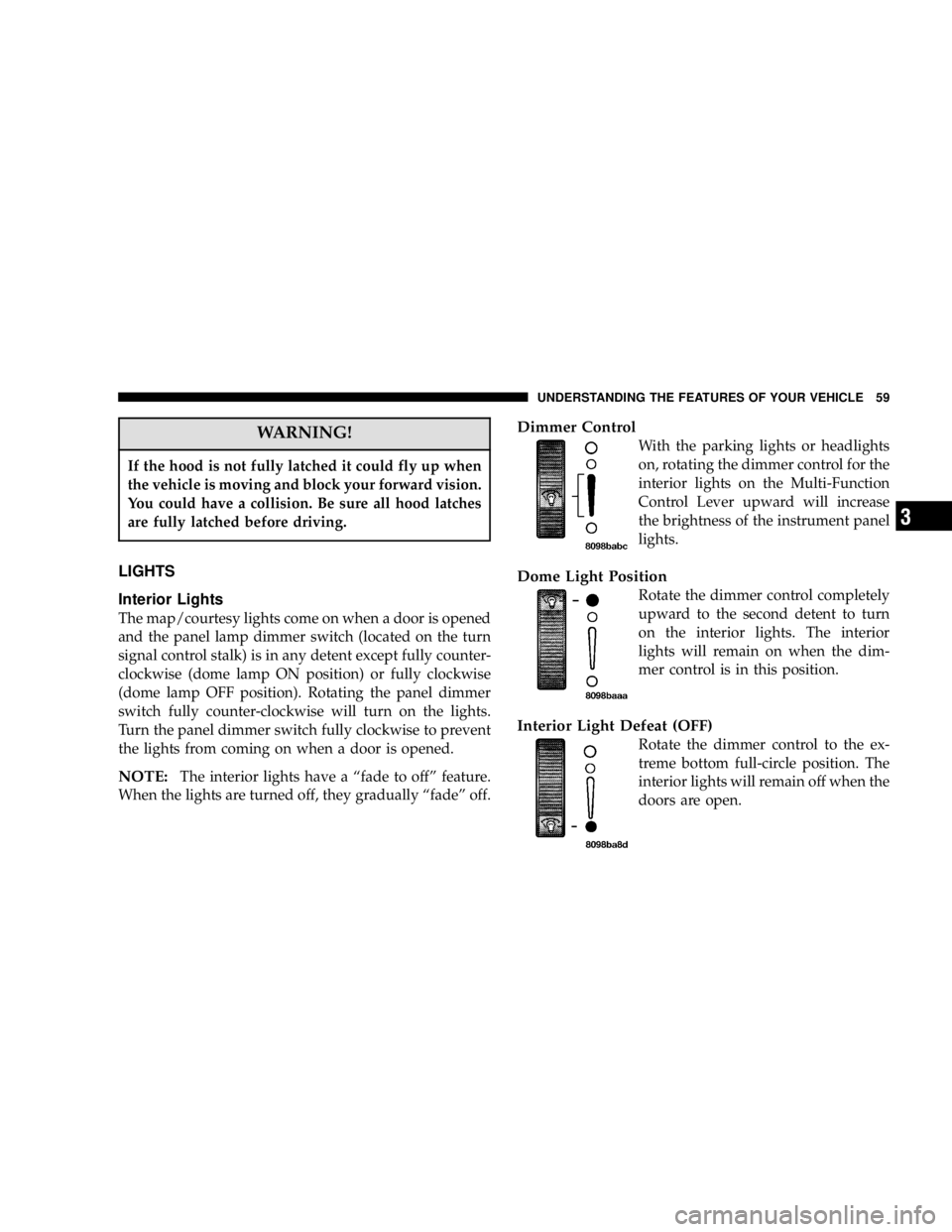
WARNING!
If the hood is not fully latched it could fly up when
the vehicle is moving and block your forward vision.
You could have a collision. Be sure all hood latches
are fully latched before driving.
LIGHTS
Interior Lights
The map/courtesy lights come on when a door is opened
and the panel lamp dimmer switch (located on the turn
signal control stalk) is in any detent except fully counter-
clockwise (dome lamp ON position) or fully clockwise
(dome lamp OFF position). Rotating the panel dimmer
switch fully counter-clockwise will turn on the lights.
Turn the panel dimmer switch fully clockwise to prevent
the lights from coming on when a door is opened.
NOTE:The interior lights have a“fade to off”feature.
When the lights are turned off, they gradually“fade”off.
Dimmer Control
With the parking lights or headlights
on, rotating the dimmer control for the
interior lights on the Multi-Function
Control Lever upward will increase
the brightness of the instrument panel
lights.
Dome Light Position
Rotate the dimmer control completely
upward to the second detent to turn
on the interior lights. The interior
lights will remain on when the dim-
mer control is in this position.
Interior Light Defeat (OFF)
Rotate the dimmer control to the ex-
treme bottom full-circle position. The
interior lights will remain off when the
doors are open.
UNDERSTANDING THE FEATURES OF YOUR VEHICLE 59
3
Page 65 of 296

WARNING!
Tilting the steering column while the vehicle is
moving is dangerous. Without a stable steering col-
umn, you could lose control of the vehicle and have
an accident. Adjust the column only while the ve-
hicle is stopped. Be sure it is locked before driving.
TRACTION CONTROL—IF EQUIPPED
To turn the Traction Control System Off, press
the switch located on the top of the steering
column, to the right of the hazard switch, until
the Traction Control indicator in the instrument
cluster lights up.
To turn the Traction Control System On, press the switch
until the Traction Control indicator in the instrument
cluster turns off.
Tilt Steering Column Control
Traction Control Switch
UNDERSTANDING THE FEATURES OF YOUR VEHICLE 65
3
Page 185 of 296
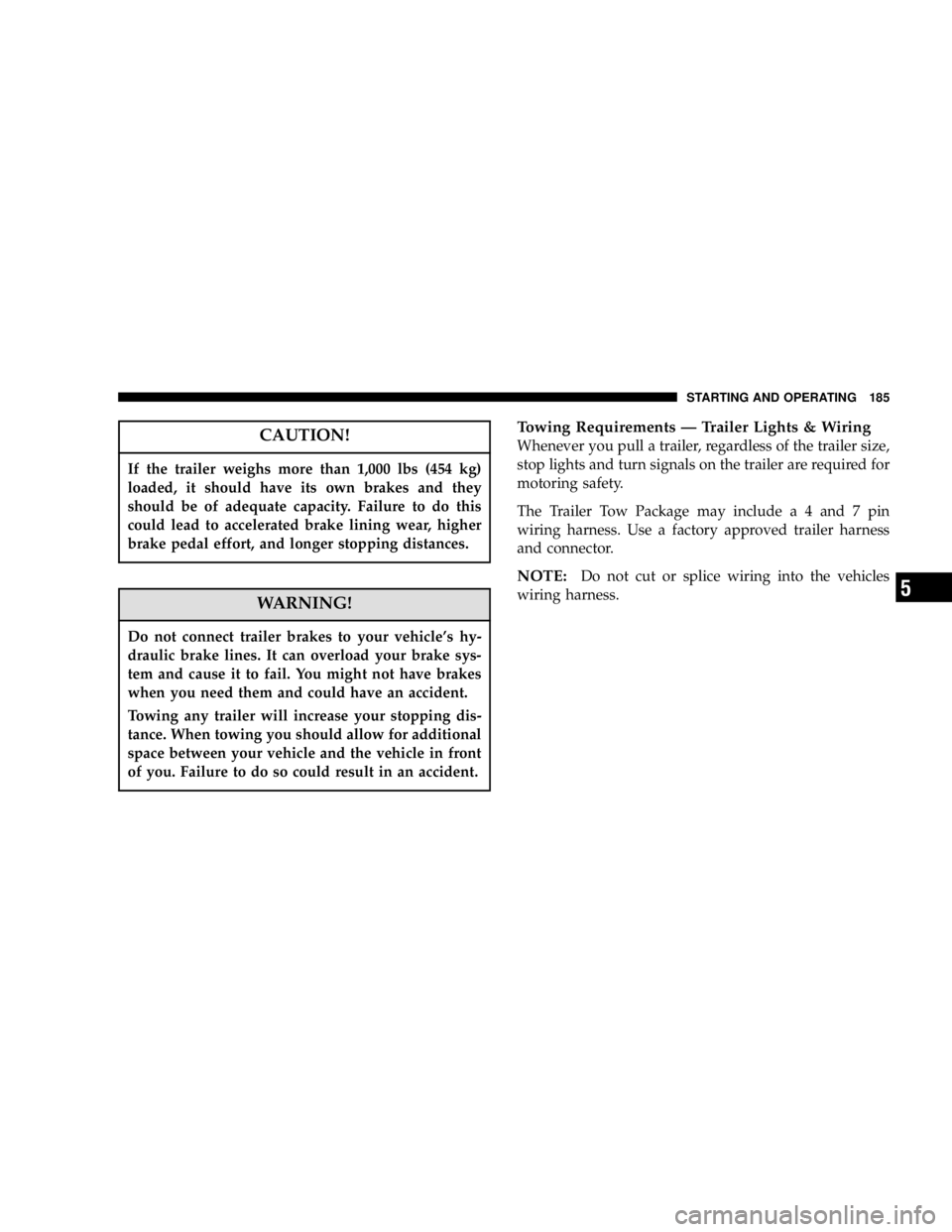
CAUTION!
If the trailer weighs more than 1,000 lbs (454 kg)
loaded, it should have its own brakes and they
should be of adequate capacity. Failure to do this
could lead to accelerated brake lining wear, higher
brake pedal effort, and longer stopping distances.
WARNING!
Do not connect trailer brakes to your vehicle’s hy-
draulic brake lines. It can overload your brake sys-
tem and cause it to fail. You might not have brakes
when you need them and could have an accident.
Towing any trailer will increase your stopping dis-
tance. When towing you should allow for additional
space between your vehicle and the vehicle in front
of you. Failure to do so could result in an accident.
Towing Requirements—Trailer Lights & Wiring
Whenever you pull a trailer, regardless of the trailer size,
stop lights and turn signals on the trailer are required for
motoring safety.
The Trailer Tow Package may includea4and7pin
wiring harness. Use a factory approved trailer harness
and connector.
NOTE:Do not cut or splice wiring into the vehicles
wiring harness.
STARTING AND OPERATING 185
5
Page 278 of 296

About Your Brakes...................... 149
ABS (Anti-Lock Brake System)............. 149
Adding Engine Coolant (Antifreeze)......... 224
Adding Fuel.......................... 177
Adding Washer Fluid.................... 222
Additives, Fuel........................ 173
Aiming Headlights...................... 246
Air Cleaner, Engine (Engine Air Cleaner Filter) . 215
Air Conditioner Maintenance.............. 218
Air Conditioning....................122,129
Air Conditioning Controls................ 122
Air Conditioning, Operating Tips........128,134
Air Conditioning Refrigerant.............. 219
Air Conditioning System..............129,218
Air Pressure, Tires...................... 161
Airbag................................ 30
Airbag Deployment....................33,34
Airbag Light...................33,34,36,46,84
Airbag Maintenance...................... 36
Airbag, Side........................... 35
Airbag, Window (Side Curtain)...........30,35
Alarm Light............................ 88
Alarm, Panic........................... 17Alarm System (Security Alarm)............. 19
Alignment and Balance.................. 167
Alterations/Modifications, Vehicle............ 6
Antenna, Satellite Radio.................. 118
Antifreeze (Engine Coolant)............224,246
Capacities........................... 246
Disposal............................ 226
Anti-Lock Brake System (ABS)............. 149
Anti-Lock Warning Light.................. 87
Anti-Theft Security Alarm (Theft Alarm)...... 19
Appearance Care....................... 233
Automatic Dimming Mirror................ 52
Automatic Door Locks..................13,14
Automatic Headlights.................... 62
Automatic Temperature Control (ATC)....... 122
Automatic Transaxle.........143,145,202,230,248
Adding Fluid........................ 248
Filter.............................. 232
Fluid and Filter Changes................ 232
Fluid Level Check..................... 231
Interlock System...................... 144
Reset Mode......................... 145
Selection Of Lubricant...............231,248
278 INDEX